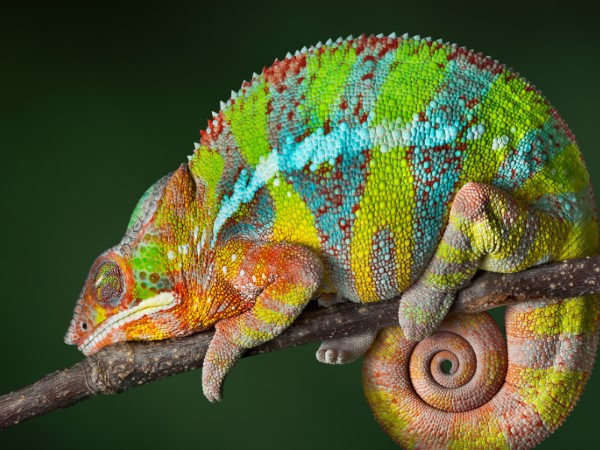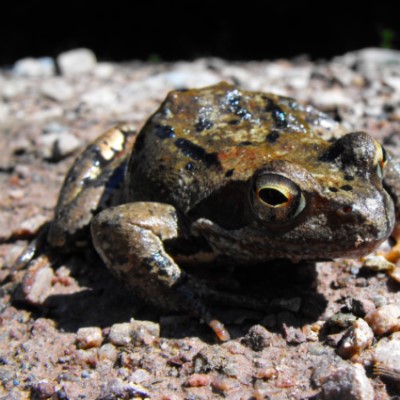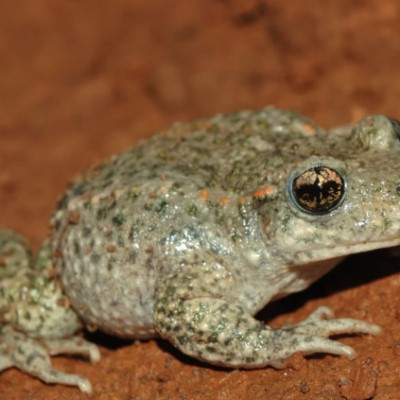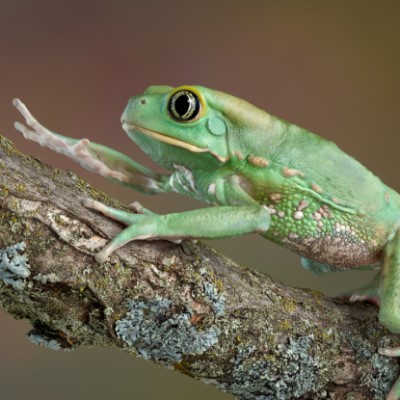- Veiled Chameleon – This chameleon grows 12 to 18 inches and is the easiest to care for because it is an arid land adapted species. Although they like humidity, like all chameleons, they can deal with less humidity and do well in homes with forced heat, even up to 120 degrees. Veiled chameleons come from the Arabian Peninsula, which is such a harsh region that it is hot in the day and cold at night.
- Jackson’s Chameleon – This cool mountainous species will grow nine to 13 inches and is especially for people who live on the West Coast or Northwest where it’s cool and humid. This chameleon can be difficult to keep. Her tank should not go above 85 degrees, and humidity must be kept high, such as the Mediterranean climate that is her natural habitat.
- Panther Chameleon – The panther chameleon adapt well. They can withstand high humidity into the 90s and yet endure a cooler temperature in the 50s. This species cannot withstand temperatures over 95 and needs more humidity than the veiled chameleon.
Housing is important for all three of these lizards, so be sure to check the housing information below.
Common Reasons for Surrender
Chameleons are most often surrendered because the care is so extensive that the owner feels he can’t take care of his chameleon anymore. Rescuers say that if you work during the day, don’t get a chameleon.
Pros
Chameleons are fun to watch. They are almost always at eye level because they like to be up in the trees. Their ability to change color is triggered by environmental and emotional changes. If they get excited about something, there will be flush of color. Some of the most beautiful colors are from males who see another male or a male who sees himself in a mirror that you hold in front of him.
Cons
Chameleons do not like to be handled and will become stressed and possibly sick if you pursue handling. Do not keep more than one chameleon in a tank. Even a male and female together will be incredibly territorial. As babies, there may be a couple of them together, and they’ll tolerate each other, but that does not last for long.
Diet
All chameleons have the same diet—they are all insectivores and eat insects. You will need to keep a variety of insects to keep them motivated in eating. If the chameleon becomes bored with her diet, she may stop eating altogether.
Once a day put live insects into a shallow bowl or into a cup that you can secure against the side of the tank. They have an extendable tongue that they fire out and grab the insects. This lizard will only drink droplets of water, so you need to spray/mist the cage every day and the Jackson needs misting twice a day.
Exercise
Tree climbing—naturally!
Possible Health Issues
Stress is the number one killer of chameleons. They are sensitive reptiles and will not do well if their cage is in a room where people are coming and going all the time. The humidity needs to be right or they can get upper respiratory disease. The diet must be right, or they can get a metabolic bone disease. Vitamin A deficiency causes issues with eyesight and edema in their legs and feet.
Housing
Housing is the same for the veiled, Jackson, and panther chameleons except for the variations in temperature and humidity. Remember to keep only one chameleon at a time in your cage. Glass irritates the chameleon, so use a large screened cage that will allow air flow and ventilation. Rescuers recommend a vertical screened cage that has a 4 ft. x 4 ft base and six foot walls on the sides. If your cage is on wheels, it’s fun to roll it outside on the deck on warm summer days. The larger the space, the less stress for your chameleon. A fig tree is the perfect tree for this lizard, as 98 percent of chameleons live exclusively in trees. Live, nontoxic plants will help contain the humidity.
Lighting is equally important for the chameleon. Secure a general UVA or UVB bulb in the top center as a general lighting structure. You will need a heat lamp (not a hot rock or heater) attached to one side of the ceiling of the cage because the chameleon is a basking lizard. Be sure that you have a branch that leans upward to the top of the cage near the basking lamp so the chameleon can climb the branch and bask. You can purchase inexpensive light timers for about $5 so that the heat lamp and the light come on together for eight hours a day and then turn off for sleep.
Grooming
Mist the Jackson chameleon twice daily, and the panther and veiled once daily. Whatever the bottom covering is must be easily cleaned. You may use news print or larger bark products made especially for reptiles. Your chameleon will almost never be on the bottom of the cage, so you can open a front door to the cage and spot clean the droppings. Wash your hands thoroughly after you are finished
Training
The closest you will get to training is to hold a mirror in front of your chameleon and watch him change colors.
Entertainment
The large dynamic environment is their entertainment. The chameleon will not be impressed with toys.
|
|
We want to thank Lancaster Herpetological Society, Lancaster, Pennsylvania, for help with this profile.






